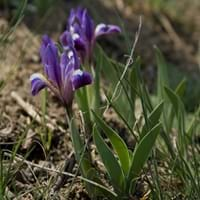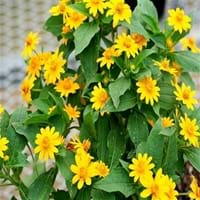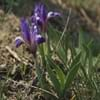Life Span
Perennial
Annual
Type
Perennial
Flowering Plants
Origin
World, Pandemic, North America, Europe, Africa, Asia
Mexico, Central America
Types
Alizes
Bumblebee Deelite
Maui Moonlight
Langport Wren
Sarah Taylor
Titan's Glory
Thornbird
Jane Phillips
Orinoco Flow
MELAMPODIUM divaricatum 'Million Gold', MELAMPODIUM leucanthum, MELAMPODIUM divaricatum
Number of Varieties
Not Available
Habitat
gardens, Hillside, Riverbanks, Warmer regions, Wet forest
Loamy soils, Sandy areas, Well Drained
USDA Hardiness Zone
Not Available
6-9
AHS Heat Zone
-9999
12 - 6
Sunset Zone
Not Available
H1, H2, 1a, 1b, 2a, 2b, 3a, 3b, 4, 5, 6, 7, 8, 9, 10, 11, 12, 13, 14, 15, 16, 17, 18, 19, 20, 21, 22, 23, 24
Habit
Clump-Forming
Clump-Forming
Minimum Height
Not Available
Minimum Width
Not Available
Flower Color
White, Yellow, Blue, Purple, Orange, Pink, Rose, Coral, Peach, Burgundy, Lavender, Plum, Orange Red, Dark Salmon, Bronze, Chocolate, Black
Yellow, Gold
Flower Color Modifier
Bicolor
Bicolor
Fruit Color
Not Available
Sandy Brown
Leaf Color in Spring
Not Available
Green
Leaf Color in Summer
Not Available
Green
Leaf Color in Fall
Not Available
Green
Leaf Color in Winter
Light Green
Light Green
Leaf Shape
Long Linear
Ovate
Plant Season
Not Available
Spring, Summer, Fall
Sunlight
Full Sun, Partial Sun
Full Sun, Partial Sun
Type of Soil
Clay, Loam, Sand
Loam, Sand
The pH of Soil
Acidic, Neutral, Alkaline
Neutral
Soil Drainage
Well drained
Well drained
Bloom Time
Not Available
Indeterminate
Tolerances
Drought
Drought
Where to Plant?
Ground, Pot
Container, Ground, Pot
How to Plant?
From Rhizomes, Stem Planting
Seedlings
Plant Maintenance
Medium
Medium
Watering Requirements
Does not require lot of watering, Keep ground moist, Water when soil is dry
Average Water Needs
In Summer
Lots of watering
Lots of watering
In Spring
Moderate
Moderate
In Winter
Average Water
Average Water
Soil pH
Acidic, Neutral, Alkaline
Neutral
Soil Type
Clay, Loam, Sand
Loam, Sandy
Soil Drainage Capacity
Well drained
Well drained
Sun Exposure
Full Sun, Partial Sun
Full Sun
Pruning
Remove dead leaves, Remove dead or diseased plant parts, Requires very little pruning
Prune in early spring, Remove damaged leaves, Remove dead branches, Remove dead leaves
Fertilizers
All-Purpose Liquid Fertilizer
slow-release fertilizers
Pests and Diseases
Bacterial Diseases, Fungal Diseases, Viruses
Red blotch
Plant Tolerance
Drought
Drought
Flower Petal Number
Single
Single
Foliage Texture
Medium
Medium
Foliage Sheen
Matte
Matte
Attracts
Bees, Butterflies
Butterflies
Allergy
Asthma
allergic reaction, Avoid during Pregnancy
Aesthetic Uses
Beautification, Showy Purposes
Showy Purposes
Beauty Benefits
Not Available
Not Available
Environmental Uses
Air purification
Air purification
Medicinal Uses
No Medicinal Use
Not Available
Part of Plant Used
Flowers, Leaves, Rhizomes, Root
Flowers, Seeds
Other Uses
Making Perfumes, Oil is used for aromatherapy, Used as a sedative, Used as essential oil
Used as Ornamental plant
Used As Indoor Plant
No
Insignificant
Used As Outdoor Plant
Yes
Yes
Garden Design
Bedding Plant, Cutflower, Mixed Border, Rock Garden, Wall
Bonsai, Container
Botanical Name
IRIS
MELAMPODIUM divaricatum 'Showstar'
Common Name
Iris
Butter Daisy
In Hindi
Iris
Butterdaisy Plant
In German
Iris
Butterdaisy Pflanze
In French
Iris
Butterdaisy Plante
In Spanish
Iris
Planta Butterdaisy
In Greek
Ίρις
Butterdaisy φυτών
In Portuguese
Íris
Butterdaisy Planta
In Polish
Irys
Butterdaisy roślin
In Latin
Iris
Planta Butterdaisy
Phylum
Tracheophyta
Magnoliophyta
Class
Liliopsida
Magnoliopsida
Order
Asparagales
Asterales
Family
Iridaceae
Asteraceae
Clade
Angiosperms, Monocots
Angiosperms, Asterids, Campanuliden, Dicotyledonous
Subfamily
Iridoideae
Asteroideae
Number of Species
Not Available
Season and Care of Iris and Butter Daisy
Season and care of Iris and Butter Daisy is important to know. While considering everything about Iris and Butter Daisy Care, growing season is an essential factor. Iris season is Not Available and Butter Daisy season is Not Available. The type of soil for Iris is Clay, Loam, Sand and for Butter Daisy is Loam, Sand while the PH of soil for Iris is Acidic, Neutral, Alkaline and for Butter Daisy is Neutral.
Iris and Butter Daisy Physical Information
Iris and Butter Daisy physical information is very important for comparison. Iris height is Not Available and width Not Available whereas Butter Daisy height is 60.96 cm and width 30.48 cm. The color specification of Iris and Butter Daisy are as follows:
Iris flower color: White, Yellow, Blue, Purple, Orange, Pink, Rose, Coral, Peach, Burgundy, Lavender, Plum, Orange Red, Dark Salmon, Bronze, Chocolate and Black
Iris leaf color: Not Available
Butter Daisy flower color: Yellow and Gold
- Butter Daisy leaf color: Green
Care of Iris and Butter Daisy
Care of Iris and Butter Daisy include pruning, fertilizers, watering etc. Iris pruning is done Remove dead leaves, Remove dead or diseased plant parts and Requires very little pruning and Butter Daisy pruning is done Prune in early spring, Remove damaged leaves, Remove dead branches and Remove dead leaves. In summer Iris needs Lots of watering and in winter, it needs Average Water. Whereas, in summer Butter Daisy needs Lots of watering and in winter, it needs Average Water.





